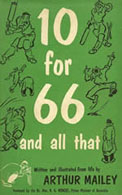 | 10 for 66 And All That Arthur Mailey 1958 |
This would have to be the hardest book to find in this list of Australian classics. My local library didn't have a copy; none of five or six second-hand bookshops had it in stock; and according to Austlit the book hasn't been reprinted since its initial publication in 1958. I was left with having to read it over a series of lunchtimes in the Victorian State Library. Not that there's anything inherently wrong with that, it's just that I have this hoarder's mentality which pushes me towards possessing my own copy whenever possible. In any event, it was an entertaining read, though you would need to be a cricket fan to get a lot out of it.
Arthur Mailey was born on January 3 1886 and played Test cricket for Australia between the years 1920 to 1926. He was a legbreak googly bowler who took 99 wickets at an average of 33.91, in 21 Tests. The title of his autobiography is explained by the Cricinfo website: "His most noteworthy achievement outside Tests was the taking of all ten wickets for 66 runs in the Gloucestershire second innings at Cheltenham in 1921, a performance which inspired the title of his autobiography in 1958: Ten for 66 And All That." A rather fortuitous statistic, it allowed Mailey to riff on the title of the comic English history book by W.C. Sellar and R.J. Yeatman. Those with some knowledge of the game will understand that taking all ten wickets in a cricket innings is a rather rare event: it has only happened about 80 times in all first-class cricket played anywhere in the world in 150 or so years, and only twice in 1879 Test matches since 1876/77. But Mailey was more than just a cricketer. At a time when Test cricketers were expected to be professional in just about everything they did, they only received an amateur's remuneration, and hence were generally required to find part-time employment along the way. Mailey took to journalism and cartooning and this book provides ample proof that he was adept at both.
There is a lot of comment on cricket and cricketers in the book, some of it now rather dated but a lot is still relevant to the cricket culture of today. And I think Mailey might have well got himself into all sorts of trouble with the media and authorities if he'd been alive during the 1990s and 2000s. Maybe not as much as Shane Warne, but Mailey would have had his moments. As to why this book is included in this list of Australian classics rather than, for example, Don Bradman's My Cricketing Life or Goodbye to Cricket, or any of the other vast numbers of Australian cricket books, I can't say. Gleeson-White notes that the book "is now recognised as one of the classics of world cricket writing, celebrated for its story of Mailey's extraordinary life...for his sharp insights into the game of cricket and for the thoughtful warmth and humour of his writing." That will do.
Notes:
The full text of this book is not available as it it is still under copyright.
Arthur Mailey Wikipedia page.
Arthur Mailey Cricinfo page.
The next four works in this Classic Year:
17. Lucinda Brayford by Martin Boyd (1946)
18. A Fortunate Life by A.B. Facey (1981)
19. Picnic at Hanging Rock by Joan Lindsay (1967)
20. "Five Bells" by Kenneth Slessor (1939)
